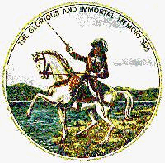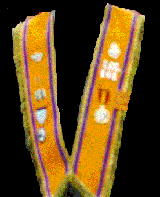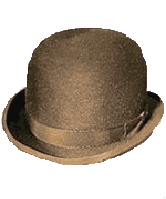
Symbols Used in Northern Ireland
|
Image |
Details |
 |
Title: Colours as Symbols Description: The colours 'orange' and 'red, white and blue' are closely associated with Unionism and Loyalism in Northern Ireland. The colours red, white and blue are the three colours of the British Union Flag. These colours are used extensively in working-class Protestant areas of the region and are painted on kerbstones, lampposts, etc. The colour orange is taken from the Orange Order which was established to celebrate the victory of King William III (William of Orange) over the Catholic King James II at the Battle of the Boyne in 1690 (see below). |
 |
Title: Acronyms as Symbols Text within image 'UDA' Description: The acronyms of Loyalist paramilitary groups, such as UDA, UFF, UVF, LVF, etc., are to be found painted on many walls in Loyalist areas of Northern Ireland. The initials are also incorporated into many other symbols such as flags and murals. |
 |
Title: Dates as Symbols Description: Quite often dates, such as '1690', are painted on walls in Protestant and Loyalist areas. Even without further reference or explanation these dates are readily understood by most people in Northern Ireland. Dates are also incorporated into things like flags and murals. |
 |
Title: Slogans as Symbols Text 'No Surrender' Description: Loyalist slogans such as 'No Surrender', 'Remember 1690', 'Ulster Says No', etc., are to be found painted on walls in many working-class Protestant areas. |
 |
Title: Crown Description: The Crown symbolises the British monarchy in Ireland. It is seen on many Loyalist murals and Orange Order banners. It is seen as the ultimate symbol of Protestantism, and allegiance is pledged to it by all who are loyal to Britain and the Protestant ascendancy in Ireland. |
 |
Title: Poppy Description: The Remembrance Day Poppy was initially used to commemorate the dead of World War I, in which many Irishmen, both Protestant and Catholic, died fighting. The symbol has long been the preserve of the Unionist community as it is seen as unequivocally British. While it can still be the cause of controversy it is slowly growing in popularity with Irish Nationalists who also wish to pay tribute to those who died in the two World Wars. |
 |
Title: King William III Text within image: 'The Glorious and Immortal Memory 1690' Description: King William III of Orange (or 'King Billy'), a Dutchman who was declared sovereign of England, Scotland and Ireland in February 1689, won the Protestant victory over Catholic King James II, a Scotsman who was deposed in December 1688, on 1 July 1690 at the Battle of the Boyne. Due to changes in the calendar the battle is celebrated every year by the Orange Order on 12 July ('the Twelth'). The image of King William crossing the Boyne River on a horse used to be very popular on murals in Protestant areas but is perhaps less used in recent years. |
 |
Title: Orange Ribbon Description: Lapel ribbons have been used for several years to demonstrate support for a number of causes. Following the use of a green ribbon by Republicans an orange version was introduced to demonstrate support for the Orange Order particularly since the refusal of the authorities to allow the Drumcree march to proceed in July 1998. |
 |
Title: Orange Order 'Sash' Description: Although commonly known as the 'sash' this item is more properly termed a collarette. The 'sash' is the most distinctive item worn by members of the Orange Order when taking part in parades. |
 |
Title: Bowler hat Description: Along with a pair of white gloves and a 'sash', the Bowler hat is part of the traditional clothing worn by Orange Order members while on parade. It is seen as the symbol of the British gentleman, and it has been suggested that it represents a symbol of authority as it was worn by the foreman on building sites or at the famous Belfast shipyards. |
 |
Title: Orangeman Symbol Description: The Orange Order was founded prior to the 1798 Rebellion, after the battle of the Diamond, to defend and uphold Protestantism and the English Monarchy. The Order commemorates the Battle of the Boyne every 12 July. This particular symbol, showing a figure wearing an Orange Sash and a Bowler hat, appeared in response to a similar Nationalist symbol which indicated that the Orange Order were not welcome. Both are based on traffic signs. The blue background represents right of way and refers to demands by the Orange Order that they should be free to walk through Catholic areas on their 'traditional' routes. |
 |
Title: British Zionist Star (Star of David) Description: The Star of David gives an unusual religious dimension to Loyalism. One interpretation is that it is meant to highlight the point of view that the Ulster Protestant people are like the Lost Tribe of Israel who are continuously persecuted. Another theory is that the star was chosen because the six points symbolise the six counties of Northern Ireland. |
 |
Title: Red Clenched Fist Description: The Clenched Fist is perhaps the strongest Loyalist emblem in existence. It is very often seen on Loyalist Paramilitary murals, and is often depicted with barbed wire surrounding it, which is the official symbol of the Loyalist Prisoner's Aid group. The fist surrounded by barbed wire is also symbolises protest against the British establishment highlighting the fact that they believe their only crime was loyalty. |
CAIN
contains information and source material on the conflict
and politics in Northern Ireland. CAIN is based within Ulster University. |
|
|
|||
|
Last modified :
|
||
|
| ||
